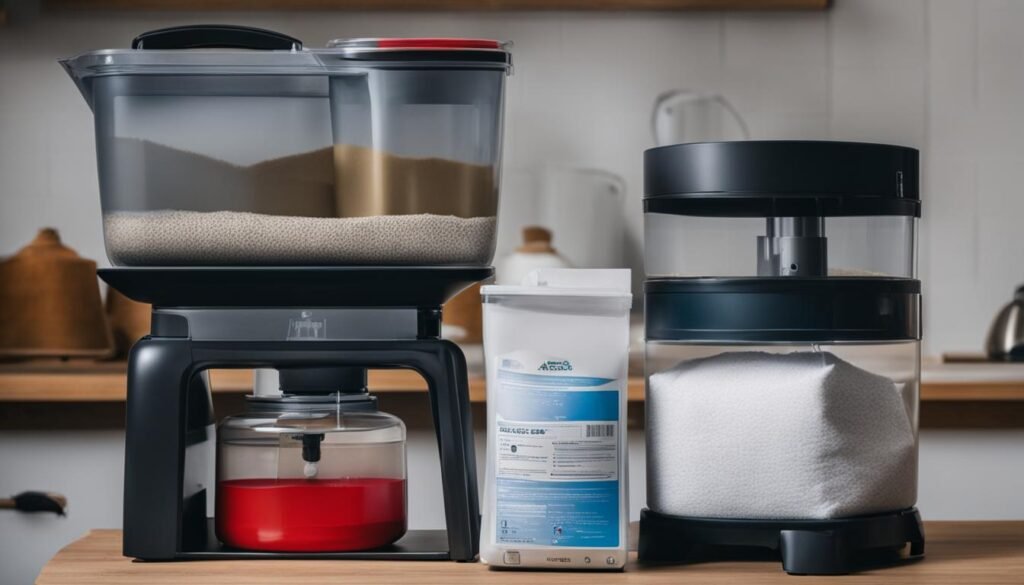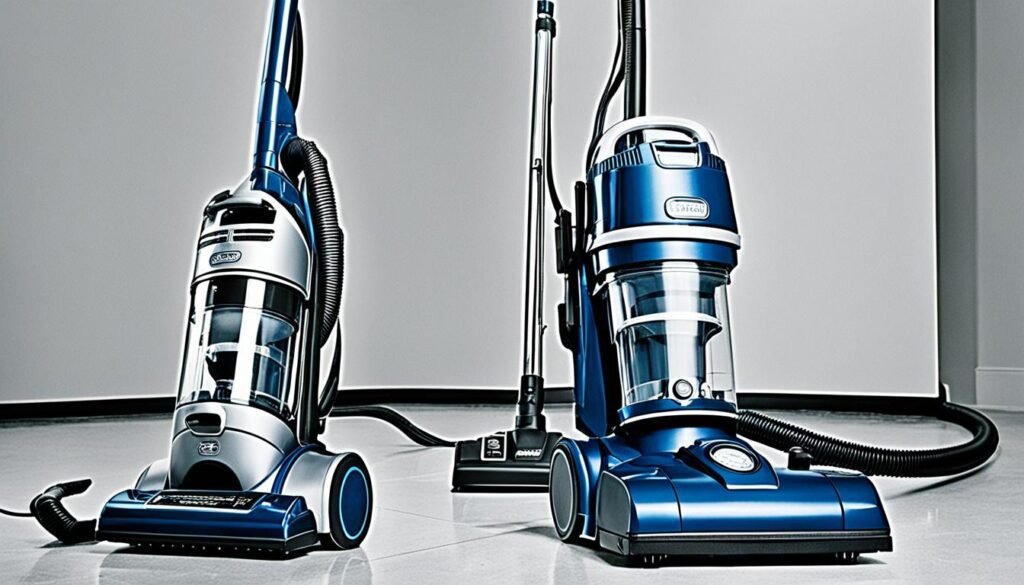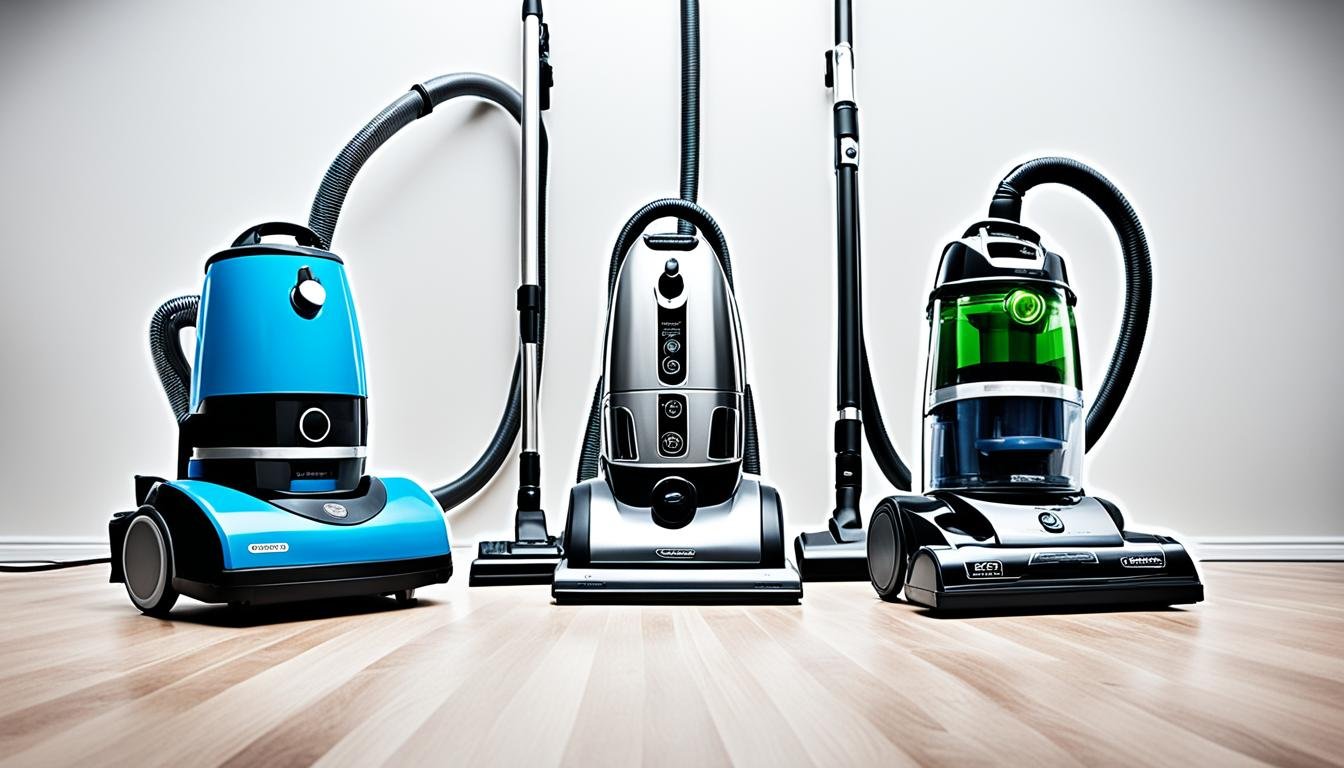Greetings, fellow cleaning enthusiasts! Today, I want to delve into a topic that has sparked spirited debates among homeowners and cleaning experts alike – the battle between bagged and bagless vacuum cleaners. If you’re in the market for a new vacuum cleaner and find yourself pondering over which type to choose, this article is here to shed some light on the matter and help you make an informed decision.
Key Takeaways:
- Bagged vacuum cleaners have superior filtration systems, making them an excellent choice for individuals with allergies or asthma.
- Bagless vacuum cleaners offer convenience and cost savings, eliminating the need for replacement bags.
- Bagged vacuum cleaners generally perform better in terms of cleaning efficiency and suction power.
- Bagless vacuum cleaners have improved significantly and now come equipped with advanced filtration systems.
- When it comes to deciding which type reigns supreme, it ultimately boils down to personal preference and specific cleaning needs.
Pros and Cons of Bagged vs Bagless Vacuum Cleaners
When it comes to choosing a vacuum cleaner, the decision between a bagged and bagless model can be a difficult one. Each type has its own set of pros and cons that are worth considering before making a purchase. In this section, I will discuss the advantages and disadvantages of both bagged and bagless vacuum cleaners, allowing you to make an informed decision.
Bagged Vacuum Cleaners
Pros:
- Excellent filtration: Bagged vacuum cleaners are equipped with sealed bags that effectively trap dust and allergens, making them an ideal choice for individuals with allergies or asthma.
- Effortless disposal: Thanks to the sealed design, bagged vacuum cleaners prevent dust and allergens from escaping during disposal, ensuring a clean and hygienic process.
- Strong suction power: Bagged models tend to maintain their suction power even as the bag fills up, ensuring consistent cleaning performance.
Cons:
- Ongoing expense: Buying replacement bags can be a recurring expense, adding to the overall cost of using a bagged vacuum cleaner.
- Limited capacity: As the bag fills up, the vacuum’s suction power may diminish, requiring more frequent bag changes for optimal performance.
Bagless Vacuum Cleaners
Pros:
- Convenience and cost savings: Bagless vacuum cleaners eliminate the need to purchase replacement bags, saving you money in the long run.
- Easy to empty: Emptying the dirt canister is a straightforward process, and you can easily see when it’s time to empty it.
- Visible dirt collection: With a transparent dirt canister, you can visually see the dust and debris being collected, providing a sense of satisfaction.
Cons:
- Messy emptying process: While convenient, emptying the dirt canister can be messy, especially if you accidentally spill some of the collected debris.
- Regular filter maintenance: Bagless models require regular cleaning of the filters to maintain optimal performance, which can be time-consuming.
- Dust and allergen release: During the emptying process, bagless vacuum cleaners may release more dust and allergens into the air, potentially affecting individuals with respiratory conditions.
“The decision between a bagged and bagless vacuum cleaner ultimately comes down to personal preference and lifestyle. Consider factors such as convenience, cost, filtration needs, and cleanliness to make an informed choice.”
| Bagged Vacuum Cleaner | Bagless Vacuum Cleaner |
|---|---|
| Excellent filtration | Convenience and cost savings |
| Effortless disposal | Easy to empty |
| Strong suction power | Visible dirt collection |
| Ongoing expense | Messy emptying process |
| Limited capacity | Regular filter maintenance |
| Dust and allergen release |

Bagged vs Bagless Vacuum Cleaner Performance and Features
When it comes to performance, bagged vacuum cleaners have long been known for their superior suction power and airflow, making them highly efficient at picking up debris in a single pass. These models excel at trapping fine dust particles, pollen, and pet dander, ensuring a thorough clean. Additionally, bagged vacuum cleaners tend to offer larger dust capacities, reducing the frequency of emptying.
However, bagless vacuum cleaners have made remarkable advancements in recent years, closing the performance gap with their bagged counterparts. Equipped with cyclonic technology, bagless models maintain strong suction even as the dirt canister fills up. Some bagless vacuums also feature HEPA filters, which efficiently capture allergens and pollutants. Nonetheless, it’s essential to note that the smaller dust capacity of bagless models may necessitate more frequent emptying, particularly in homes with pets or high-traffic areas.
Both bagged and bagless vacuum cleaners offer unique features that cater to different cleaning needs. The decision between the two ultimately depends on personal preferences and priorities.
Bagged Vacuum Cleaners
Bagged vacuum cleaners have been a trusted choice for individuals with allergies or asthma due to their exceptional filtration capabilities. The sealed bags securely contain dust and allergens during disposal, minimizing their release into the air. This makes bagged models highly effective in maintaining air quality and reducing respiratory irritants.
However, it’s important to consider that bagged vacuum cleaners require the ongoing expense of purchasing replacement bags. Furthermore, as the bag fills up, the suction power may gradually diminish, necessitating more frequent bag changes to maintain optimal performance.
Bagless Vacuum Cleaners
Bagless vacuum cleaners offer the convenience of eliminating the need for replacement bags, providing cost-saving benefits in the long run. Emptying the dirt canister is a straightforward process, and the transparent design allows users to easily see when it’s time to empty. This feature can be particularly helpful in gauging the amount of dirt accumulated and ensuring efficient cleaning performance.
However, emptying the canister of bagless models can be messy, potentially releasing more dust and allergens into the air during disposal. Regular cleaning of the vacuum’s filters is necessary to maintain optimal performance and prevent clogging. It’s worth noting that bagless models typically have smaller dust capacities, requiring more frequent emptying, especially in households with pets or high levels of foot traffic.

Despite their differences, both bagged and bagless vacuum cleaners have their own set of advantages and considerations. Selecting the right vacuum cleaner depends on individual preferences, cleaning requirements, and lifestyle factors. It’s important to carefully evaluate the performance and features of each type to make an informed decision.
Conclusion
In conclusion, when it comes to choosing between bagged and bagless vacuum cleaners, the decision ultimately depends on individual preferences and specific cleaning needs.
Bagged vacuum cleaners have significant advantages in terms of filtration and allergy-friendly features, making them an excellent choice for individuals with respiratory conditions. The sealed bags effectively trap dust and allergens during disposal, ensuring clean and breathable air. Additionally, bagged models often have larger dust capacities, reducing the frequency of emptying.
On the other hand, bagless vacuum cleaners offer convenience and cost savings. With no need to buy replacement bags, they eliminate ongoing expenses and reduce environmental waste. Bagless models have also improved their performance capabilities, with technologies like cyclonic suction and HEPA filters now rivaling the filtration efficiency of bagged counterparts.
Ultimately, when considering which type of vacuum cleaner is best for your home, it’s essential to take into account your cleaning requirements, budget, and lifestyle. Whether you prioritize advanced filtration or ease of use, both bagged and bagless vacuum cleaners have unique advantages that can meet your cleaning needs effectively.
FAQ
What are the pros and cons of bagged vacuum cleaners compared to bagless ones?
Bagged vacuum cleaners offer superior filtration and are ideal for individuals with allergies or asthma. They effectively trap dust and allergens and prevent them from escaping during disposal. However, buying replacement bags can be an ongoing expense. On the other hand, bagless vacuum cleaners eliminate the need for bags, providing convenience and cost savings. However, emptying the dirt canister can be messy, and the filters need regular cleaning.
How do bagged and bagless vacuum cleaners perform in terms of cleaning efficiency?
Bagged vacuum cleaners generally perform better in terms of cleaning efficiency and suction power compared to bagless models. They have stronger suction power and better airflow, allowing for more effective debris pickup in a single pass. Bagged models also tend to have larger dust capacities, requiring less frequent emptying. However, bagless vacuum cleaners have made significant advancements and now offer comparable performance, with features like cyclonic technology and HEPA filters.
What are the advantages of bagged vacuum cleaners?
Bagged vacuum cleaners excel in terms of filtration and allergy-friendly features. They effectively trap dust, pollen, and pet dander, making them a great choice for individuals with respiratory conditions. The sealed bags prevent dust and allergens from escaping during disposal, ensuring a cleaner environment. Additionally, bagged models often have larger dust capacities, reducing the frequency of emptying.
What are the advantages of bagless vacuum cleaners?
Bagless vacuum cleaners offer convenience and cost savings since there are no bags to buy. Emptying the dirt canister is a straightforward process, and you can easily see when it’s time to empty it. Bagless models have also improved in terms of performance, with features such as cyclonic technology and HEPA filters. However, emptying the canister can be messy, and the filters require regular cleaning to maintain optimal performance.






Leave a Reply